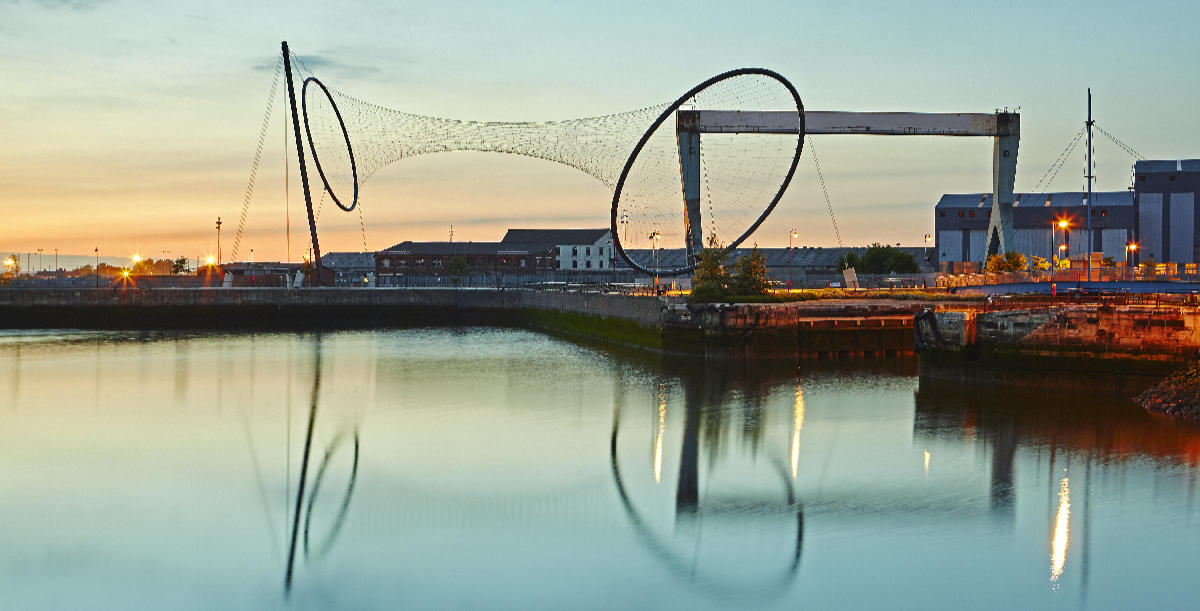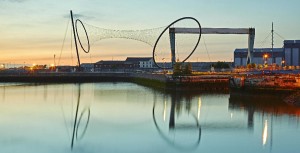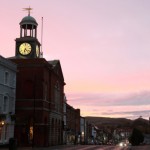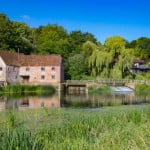
Middlesbrough is a large industrial town that lies on the south bank of the River Tees in North Yorkshire, north-east England. The town lies some 4 miles west of the North Sea coast, 16 miles (26 km) east of Darlington and about 40 miles (64 km) south of Newcastle. The town was founded together with its port at the mid-term of England’s industrial revolution. It has ever since that time, been closely associated with heavy industry and shipping.
A Fleeting History
The name Middlesbrough, first recorded as ‘Mydilsburgh’, dates back to Saxon times. ‘Burgh’ refers to an ancient settlement, and ‘Mydil’ is thought to be either the name of a local Anglo-Saxon leader or a reference to Middlesbrough’s mid-location, i.e. halfway between the settlements of Durham and Whitby.
The earliest recorded settlement in the Middlesbrough area was of a small chapel (or cell) belonging to Whitby Abbey dating back to Anglo-Saxon times of the late 7th Century. During the 9th century, the Vikings began to colonise the area, eventually driving out the Anglo-Saxons. One of their legacies has been to leave a number of Middlesbrough’s suburbs, such as Ormesby, Stainsby, Maltby, and Tollesby, with names of Viking origin.
Despite this early activity around the Teesside area, at the beginning of the 19th century, Middlesbrough itself was still only a small agricultural settlement of about 25 people.
Middlesborough Begins To Grow
In 1829, a group of Quaker businessmen headed by Joseph Pease of Darlington, purchased the 527 acres Middlesbrough farmstead and associated estate, with a vision to develop a port and new town. The town was to be built on the banks of the River Tees, just to the west of the new port complex, and in the original plan was to be named `Port Darlington’.
Forming part of Pease’s proposal, the New Town was to house the large influx of manual workers that would be required for the operation of the new coal port. By 1830, the celebrated Stockton to Darlington railway, which had largely been the vision of Pease’s father, Edward, was extended to Middlesbrough. This was a catalyst for the expansion of the new town and port.
Under Joseph Pease’s blueprint, North Street, South Street, West Street, East Street, Commercial Street, Stockton Street, Cleveland Street, Durham Street, Richmond Street, Gosford Street, Dacre Street, Feversham Street and Suffield Street, were laid out in a grid pattern, centred around a market square. Business, industry and traders quickly bought up the available premises and land in the town.
The success of the port meant it was soon overwhelmed by the volume of imports and exports. Thus, in 1839, construction began on Middlesbrough’s dock. Opening in 1842, the docks were immediately bought up by the Stockton & Darlington Railway Company, which had Joseph Pease as its main shareholder.
In 1841, industrialists Henry Bolckow and John Vaughan partnered up and started an iron foundry at the town’s Vulcan Street. In 1850, it was Vaughan who discovered large local ironstone deposits at Eston Hills. By 1851, following the great influx of migratory workers, the population of Middlesbrough had grown to around 7,600, an increase of almost two hundred-fold from the populace of about 40 in 1829. Middlesbrough’s was now well on the way to replacing Stockton as the main port on the Tees.
Royal Charter
In 1853, Middlesbrough received its Royal Charter, and Henry Bolckow took up office as the town’s first mayor. Between 1851 and 1856, the production of pig iron in the town rose by 1000%. By the mid-1870s, Middlesbrough was responsible for producing a third of the country’s entire pig iron output. In 1875, Bolckow, Vaughan & Co. opened the Cleveland Steelworks in the town, beginning the transition from iron to steel production.
By 1900, Bolckow, Vaughan & Co. had become the largest steel producer in the country, and Teesside as a whole, one of the major steel centres in the world. By this time, the population of Middlesbrough had reached some 90,000.
In 1929, Dorman Long, another major Middlesbrough based steelmaker (est. 1875), took over Bolckow, Vaughan & Co., becoming the dominant steel producer on Teesside. The company were also synonymous with building long-span bridges, having engineered and fabricated the steel components of Newcastle’s Tyne Bridge, the contract was completed in 1928. Dorman Long went on to build significant bridges around the world, but perhaps the most prestigious was the Sydney Harbour Bridge, which was completed in 1932.
WWII Middlesborough
During WW2, Middlesbrough became an obvious industrial target for the Luftwaffe. In 1940, it became the first major British town to be bombed, when a lone enemy plane dropped 13 bombs. By the end of the war, more than 200 buildings had been destroyed in and around Middlesbrough. Almost immediately, areas of Victorian housing were demolished and redevelopment of much of the centre of Middlesbrough began. The opportunity was also taken to relocate heavy industry to more suitable locations on the outskirts of the town. By the 1950s, Middlesbrough had begun to take on a different look from its former self.
The Modern Era
In 1968 Middlesbrough became part of the County Borough of Teesside. In 1974, during local government reorganisation, it became part of the non-metropolitan county of Cleveland. In 1996, further reorganisation saw the county abolished, and Middlesbrough became a unitary authority.
Once dominated by steelmaking, shipbuilding and chemical production, the industrial face of Middlesbrough has changed significantly since its boomtown days of the late 19th and early 20th century. Since the demise of most of the old heavy industry in the area, new technologies have begun to emerge to take their place, such as the digital sector. This sector is in particular served by Middlesbrough University, which has a growing reputation for developing digital businesses, especially in the field of digital animation.
However, Middlesbrough and the Tees Valley, in general, is still home to a large manufacturing and engineering businesses base. These industries range from aerospace and automotive to renewable energy and chemicals. The strength of manufacturing in the Middlesbrough area is largely due to the thriving process, offshore, and energy sectors, which form its industrial economic base.
The port of Teesport, owned by PD Ports, a UK headquartered port, shipping and logistics company, is a major contributor to the local economy of Middlesbrough. Teesport stands on the Tees estuary, about a mile from the North Sea and 4 miles east of Middlesbrough. The port estate covers almost 800 acres, currently handles some 4,350 vessels and around 27 million tonnes of freight per year.
Middlesbrough also has a strong retail sector which is mostly served by the town centre, which consists of four shopping centres, the largest of being the Cleveland Centre.
A Few Quick Facts
The town is currently twinned with Middlesboro, Kentucky, USA; Masvingo, Zimbabwe; Oberhausen, North Rhine-Westphalia, Germany and Nord, Hauts-de-France, France.
At the 2011 UK Census, Middlesbrough had a population of 138,400.
In 1728, James Cook was born in Marton-in-Cleveland, a suburb of today’s Middlesbrough. Cook, perhaps Middlesbrough’s most famous son, went on to become one of Britain’s most renowned Royal Navy officers and explorers.
Places to see!
Transporter Bridge
The Transporter Bridge, built-in 1911, spans the River Tees between Middlesbrough and Port Clarence. At 260 m long and 69 m high, it has claims on being the biggest of the kind in the world, and one of only two left in Britain that’s still in working order. The bridge, a Grade II listed structure, remains in daily use. There’s a guided tour of the bridge’s upper walkway, via a glass lift or in a glass gondola over the river. You can also opt to walk or bike the length of the bridge.
Dorman Museum
Located in Middlesbrough’s Albert Park is the Dorman Museum, which largely houses social history exhibitions. It opened in 1904, and since then, its teal dome has become one of the town’s most iconic landmarks. Opening Hours are: Tuesday – Sunday 10:30am – 3:30pm
Middlesbrough Institute of Modern Art
In the centre of town, you will find the Middlesbrough Institute of Modern Art. Art exhibitions and displays range from sculptures, prints and photographs. After your tour, it obviously has its own Café where you can chill for a bit. Opening times are: Tuesday, Wednesday, Friday & Saturday, 10am – 4:30pm; Thursday 10am – 7pm; Sunday 12pm – 4pm
The Temenos sculpture

Image: A G Baxter/Shutterstock.com
Seeing this incredible sculpture by Sir Anish Kapoor is almost enough its self to make a trip to Middlesbrough worthwhile. Standing 164ft (50m) and spanning 360ft (110m) long. this steel & wire creation took over 4 months to assemble and reputedly cost £2.7m. You can find it on the banks of the River Tees near the Transporter Bridge.
Things to do!
Watch football
The Riverside Stadium on the banks of the River Tees is home to Championship (England’s 2nd tier of professional football) side, Middlesbrough FC. League matches mostly take place every other Saturday between August and April, with the odd game on a Sunday or mid-week.
Stewart Park
As well as picnicking or just taking a stroll through the park, you could also visit the famous Captain Cook Birthplace Museum and learn about the illustrious navigator’s life. If you with kids, you might want to head on to the pets’ corner where there are domesticated llamas, goats, cattle, and other animals are being cared for by the park officials.
Getting there and around!
Road
If you are driving to Middlesbrough, then there are two arterial roads that serve the town, the A66 and the A19. The trans-Pennine A66 connects to the west with the town with nearby Darlington and further afield, the county of Cumbria. The A19 runs north to south, connecting the town with Sunderland and Newcastle northwards, and with York and most of the rest of Yorkshire to the south.
Train
Middlesbrough railway station lies on the Tess Valley Line. All services are operated by Northern Rail, except those to Manchester which are run by TransPennine Express. All trains on the Tees Valley Line and Durham Coast Line call at the station, giving it hourly services northbound to Sunderland and Newcastle and 30 minutes to Darlington and Saltburn. The Esk Valley Line to Whitby runs via Nunthorpe and Grosmont. It’s not possible to get a train directly from London to Middlesbrough. At the very least, you must make one change at North Allerton, with that journey usually taking just over 3 hours. Less well-planned journeys from London can involve up to 4 changes and take almost 7 hours.
Bus
The Town is served locally, by Arriva North East and Stagecoach bus services, which provide the majority of bus services in and around the town. National Express and Megabus operating long-distance coach travel to and from Middlesbrough bus station.
Air
Durham Tees Valley Airport (formerly Teesside Airport) is located several miles west of the town. The airport offers domestic and international flights, the latter being particularly to EU countries. Newcastle International Airport (NCL) offers an alternative destination from which to arrive/leave the area. The connecting journey between Newcastle Airport and Middlesbrough is about 1 hour by taxi and 2 hours by train.
Where to stay?
Hotel: £60 – £80 (2 people sharing)
Lodge/B & B/Guesthouse: £40 – £60
Apartment/Holiday home: £80 – £120 (usually sleeping 2 – 6 people)
The Middlesborough Quiz
Quiz Maker – powered by Riddle
So there you have it our Five Minute Overview of Darlington and a quick quiz to see if you were paying attention! Before you go why not try some of our other quizzes or have a look at some of our other location guides. better still why not join our growing community it’s free and could be very rewarding going forward.





